 Image search results - "Gujo" Image search results - "Gujo" |
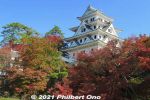
Gujo-Hachiman Castle is on a small mountain named Mt. Hachiman in central Gujo-Hachiman. The main tenshu tower is a 1933 reconstruction made of wood and surrounded by autumn foliage in November.Takes about 15 minutes to climb up. It's a fairly easy climb. The castle has a commanding view of the city.
|
|
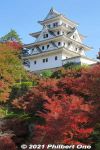
The main tower is now a museum exhibiting local history and culture. The top floor gives commanding views of Gujo-Hachiman.
|
|
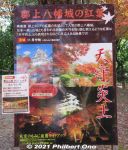
Small admission is charged to enter the castle's main tower. A combination ticket ¥700 is recommended to also see Jion-zenji Temple
|
|
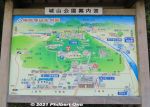
Map around Gujo-Hachiman Castle. The castle is a short uphill hike from the bus stop at Gujo-Hachiman Jokamachi Plaza, a local tourist shop. Gujo-Hachiman used to be a separate town (municipality) called "Hachiman-cho" until it merged with several neighboring towns and villages to form the city of Gujo (pop. 38,000) in 2004.
|
|
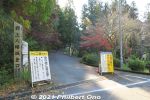
Entrance to the road going up to the castle. Both cars and pedestrians use this narrow, single-lane road, so we all need to be careful.
|
|
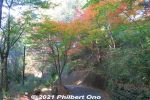
Takes about 15 min. of uphill walking. Cars can go up to the parking lot near the castle. People in wheelchairs should take a taxi. However, the castle grounds still has a lot of stone steps. Castle tower has no elevator.
|
|
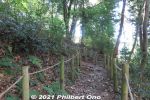
The road snakes up the mountain, but pedestrians can also go up a few shortcuts. Steeper than the road though.
|
|
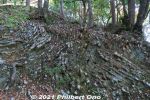
Unusual rock formations.
|
|
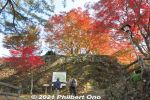
Finally reached the bottom of the castle grounds. Fall leaves already pretty in mid-November.
|
|
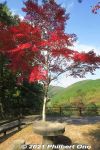
Gujo-Hachiman Castle has lots of red maples.
|
|
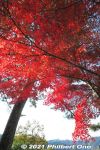
Nice red momiji maple leaf gradation from light to dark.
|
|
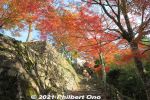
The pedestrian approach to the castle entrance is also pretty with autumn leaves.
|
|
|
|
|
|
|
|
|
|
|

Major spot to view and photograph the castle. The stone monument is connected with Nichiren.
|
|
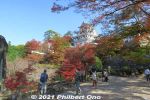
View of Gujo-Hachiman Castle and fall leaves.
|
|
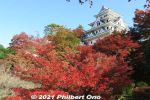
Gujo-Hachiman Castle and red maple leaves.
|
|

Gujo-Hachiman Castle and autumn foliage.
|
|

Gujo-Hachiman Castle and autumn foliage.
|
|
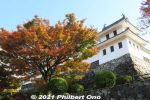
Gujo-Hachiman Castle corner turret.
|
|
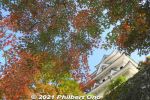
Autumn view of Gujo-Hachiman Castle from a path along the castle wall.
|
|
|
|
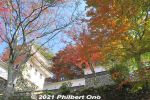
Another corner turret.
|
|
|
|
|
|
|
|
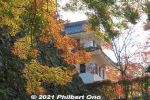
Gujo-Hachiman Castle turret and autumn foliage.
|
|
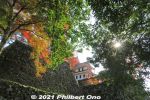
Gujo-Hachiman Castle turret and autumn foliage.
|
|
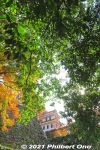
Gujo-Hachiman Castle turret and autumn foliage still green.
|
|
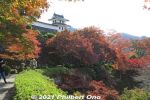
Gujo-Hachiman Castle corner turret and autumn foliage.
|
|
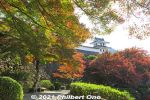
Gujo-Hachiman Castle corner turret and autumn foliage.
|
|
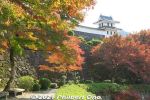
Gujo-Hachiman Castle corner turret and autumn foliage.
|
|
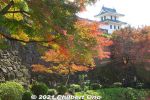
Gujo-Hachiman Castle corner turret and autumn foliage.
|
|
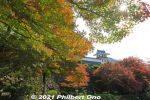
Gujo-Hachiman Castle corner turret and autumn foliage.
|
|
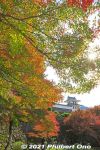
Gujo-Hachiman Castle corner turret and autumn foliage.
|
|
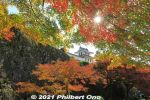
Gujo-Hachiman Castle corner turret and autumn foliage.
|
|
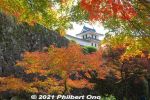
Gujo-Hachiman Castle corner turret and autumn foliage.
|
|
|
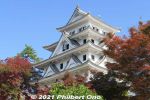
Gujo-Hachiman Castle main tower.
|
|

Chikara-ishi stones.
|
|
|
|
|
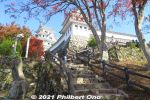
Steps to the castle's main keep.
|
|
|
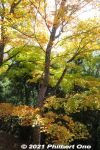
Lots of autumn colors along the way.
|
|
|
|
|
|
|
|
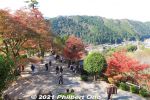
Prime spot to view and photograph the castle.
|
|
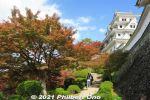
Path along the castle wall leading to another turret.
|
|
|
|
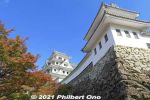
Corner turret.
|
|

Main tower.
|
|

Castle wall with openings for weapons.
|
|

About Gujo-Hachiman Castle in Japanese. Gujo-Hachiman Castle was first built in 1555 by Lord Endo Morikazu as his base when he was battling another feudal lord, Tono Tsuneyoshi, for the control of the Gujo domain. Morikazu's son Yoshitaka then unified the Gujo domain and built the castle and castle town.
The succeeding lord, Inaba Sadamichi, built the castle main tower. The castle later had other samurai clans as occupants such as the Endo, Inoue, and Kanamori Clans.
|
|
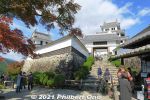
Near the gate to the main tenshukaku tower.
|
|
|
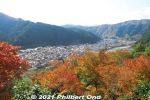
View of Gujo-Hachiman in autumn, south of Yoshida River.
|
|
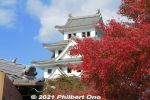
Main tower and red maples.
|
|
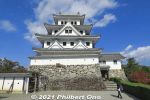
Gujo-Hachiman Castle's tenshu main tower. Reconstruction built in 1933. The original castle was dismantled in 1870 when the samurai system was abolished. Only the stone walls and foundations remained. This reconstruction is unusual because it was built using wood instead of concrete. This is in fact Japan's oldest reconstructed main castle tower made of wood.
Entrance to the castle tower can be seen on the right. Small admission charged.
|
|
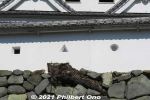
Castle tower had a tree growing in the foundation.
|
|
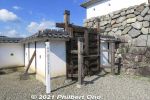
Another gate.
|
|
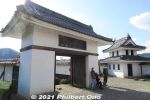
Main gate to the castle's main tower.
|
|
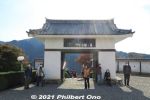
Main gate to the castle's main tower.
|
|
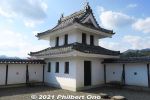
Gujo-Hachiman Castle corner turret. Not open to the public.
|
|

Defensive wall with holes for weapons.
|
|
|
|
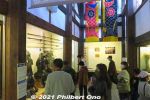
Inside Gujo-Hachiman Castle's main tower, a museum exhibiting local historical artifacts. This is the first floor. In the background, you can see Koinobori carp streamers made by local artists.
|
|
|
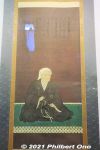
Scroll painting of Chiyo, famous wife of Yamauchi Kazutoyo in the 16th century. Chiyo was supposedly the daughter of the Gujo-Hachiman Castle's first lord, Endo Morikazu.
|
|

Historical letters and documents.
|
|
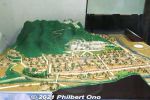
Scale model of Gujo-Hachiman Castle town during the samurai days. The castle is on the top of the mountain.
|
|

Wooden stairways to go up to the upper floors. High heels and short skirts not recommended.
|
|
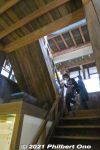
Wooden stairways to go up to the upper floors.
|
|
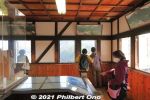
Top floor of the castle tower is a lookout deck with open windows (no glass). Very breezy.
|
|
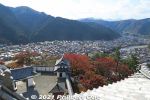
Great views of Gujo-Hachiman from the top floor of the castle tower. This is looking south (Minami-machi) and that's Yoshida River.
|
|
|

View of Gujo-Hachiman from the castle. Looking south with Yoshida River in the foreground. Miyagase Bridge over Yoshida River can also be seen.
|
|

Jokamachi (castle town) area of Gujo-Hachiman. The large temple roof would be Anyoji Temple.
|
|
|
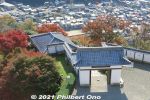
Main gate to the castle tower.
|
|
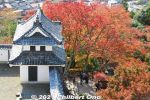
Corner turret.
|
|
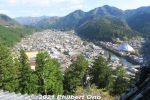
Back view of Gujo-Hachiman. Ono district with Yoshida River on the right. The covered stadium on the right of the river is Sogo Sports Center. (郡上市 総合スポーツセンター)
|
|
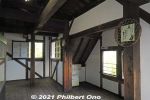
Lower floor in the castle tower.
|
|
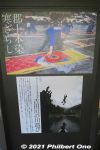
Panel display of local activities on the river.
|
|
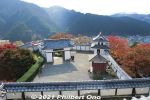
View from the lower floor.
|
|

The much photographed corner turret.
|
|
|
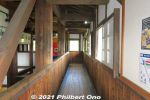
Corridor on a lower floor of the main castle tower.
|
|
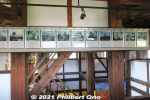
Photo gallery of other castles.
|
|
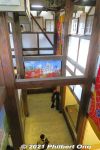
First floor.
|
|
|
|
|
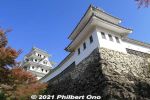
Corner turret and main tower.
|
|
|
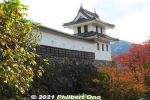
Corner turret.
|
|
|

Another turret. Not open to the public.
|
|
|
|
|
|
|
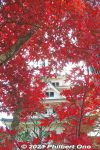
Red maples behind the main tower.
|
|
|
|
|
|
|
|
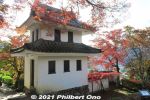
Turret sprinkled with red maple leaves.
|
|
|
|
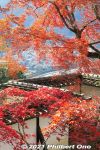
Castle wall and red maples.
|
|
|
|
|
|
|

Lots and lots of autumn colors at Gujo-Hachiman Castle.
|
|
|
|
|
|
|
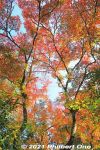
Some leaves on the way back down the mounatin.
|
|
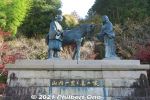
At the foot of the castle mountain, there's this statue of samurai Yamauchi Kazutoyo and his loyal and loving wife Chiyo and the fine horse she bought for him (in Kinomoto or Azuchi, Shiga Prefecture) with her own money in the 16th century.
|
|
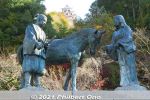
Chiyo was supposedly the daughter of the Gujo-Hachiman Castle's first lord, Endo Morikazu. Kazutoyo later became lord of Kochi Castle in Shikoku. This statue was erected in 1991 by local donors. (Gujo-Hachiman Castle can be seen in the background.)
|
|

Kazutoyo and Chiyo were made nationally famous by the year-long NHK Taiga Drama series Kōmyō ga Tsuji (功名が辻) in 2006.
|
|
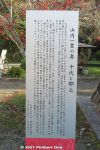
About Chiyo and Kazutoyo in Japanese.
|
|
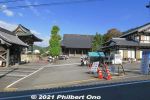
On the way to the castle, you will pass by Anyoji Temple. Jodo Shinshu Buddhist Sect, Otani School. Founded in 1256. 安養寺
|
|

Anyoji Temple's main Hondo worship hall is the largest wooden building in Gifu Prefecture. Small admission charged to enter the worship hall. 安養寺
|
|

View of Anyoji Temple's main hall. One of Gujo-Hachiman's major temples. 安養寺
|
|
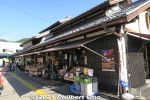
One good starting point for touring Gujo-Hachiman is here, Gujo-Hachiman Jokamachi Plaza. A small tourist shop with a large parking lot for bus stops and tour buses. Centrally located. Hike up to the castle from here.
|
|
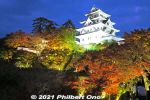
During the autumn foliage, Gujo-Hachiman Castle and autumn leaves are lit up in the evening from 5 pm. No admission charged.
|
|
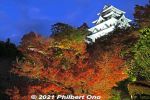
It was kind of tiring to climb up the mountain for the second on the same day to see the evening light-up. But it was worth it. Took 20 min. to take some quick photos before going back down to catch the bus back to Gifu Station.
|
|
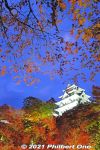
Gujo-Hachiman Castle and autumn leaves are lit up in the evening.
|
|
|
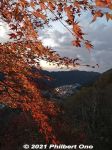
View of Gujo-Hachiman and autumn leaves.
|
|
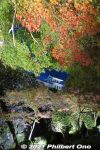
Gujo-Hachiman Castle's corner turret and autumn leaves lit up in the evening
|
|
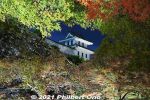
Gujo-Hachiman Castle's corner turret and autumn leaves lit up in the evening
|
|

How to get to Gujo-Hachiman: Taking a bus from JR or Meitetsu Gifu Station or Nagoya Station is most convenient. This is the bus for Gujo-Hachiman at Meitetsu Gifu Station.
|
|
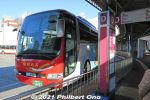
Bus fare is only ¥1,550 from Meitetsu Gifu Station. It takes 80 min. Gujo-Hachiman is not as far north as Shirakawa-go or Takayama, so it's an easy day trip.
|
|
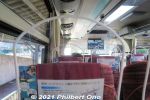
The bus for Gujo-Hachiman has these plastic barriers for COVID-19.
|
|
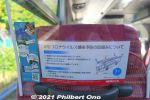
It says the ventilation system in the bus completely changes the interior air every 5 min.
|
|
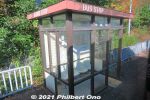
Bus stop on the highway to Gujo-Hachman.
|
|
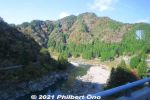
The bus ride to Gujo-Hachman is scenic through the mountains.
|
|
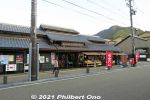
Get off at this bus stop, Gujo-Hachiman Jokamachi Plaza, a small tourist shop with a large parking lot.
|
|

When getting off the bus, check the bus schedule for your return trip. Be aware that buses are infrequent. Only once an hour or less often.
|
|

Jion-zenji (also called Jionji) is a Rinzai Zen Buddhist temple (Myoshinji School). On the fringe of central Gujo-Hachiman. Walking distance from the castle.
|
|

In autumn, Jion-zenji Temple is a major attraction for autumn leaves in Tessoen Garden.
|
|

About Jion-zenji Temple. It worships Yakushi, the healing Buddha.
|
|
|
|
|
|
|
|
|
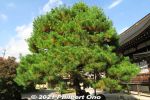
Nice pine tree at Jionji Temple.
|
|
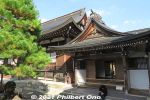
Tessoen Garden admission is ¥500 as of autumn 2021.
|
|
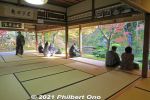
Room to view Tessoen Garden. We can only view the garden from this room and cannot walk in the garden.
|
|
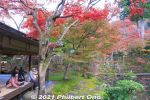
Jion-zenji Temple's Tessoen Zen garden is Gujo-Hachiman's second most famous spot for autumn colors.
|
|
|
|

Tessoen Garden has a small waterfall.
|
|
|
|
|
|
|
|
|
|
|
|
|
|
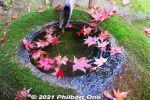
Suikin-kutsu water basin that makes a leasant sound with water droplets. 水琴窟
|
|
|

Rock garden in the inner courtyard.
|
|
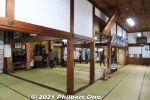
Inside the Hondo main temple hall.
|
|

Jion-zenji worships Yakushi, the healing Buddha. 薬師
|
|
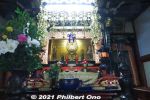
You can pray for whatever you want here. Family harmony, traffic safety, passing exams, business prosperity, recovery from illness, etc., etc.
|
|

Adjacent altar for other Buddhas.
|
|
|
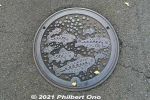
Gujo-Hachiman manhole has ayu sweetfish design.
|
|
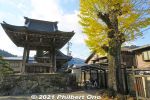
Temple bell and ginkgo tree at a neighborhood temple.
|
|
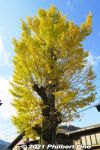
Ginkgo tree at a neighborhood temple.
|
|

On this small Otohime Stream is this water shed covering a dammed part of the river where locals can wash potatoes. Natural spring water.
|
|
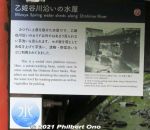
Water shed is called "mizuya." 水屋
|
|
|
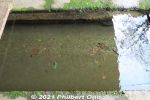
Water looks clean enough for washing potatoes.
|
|
|
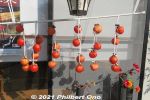
Persimmons out to dry.
|
|
|
|
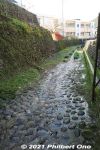
Otohime Stream
|
|
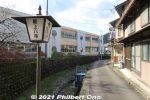
Gujo-Hachiman street lamp and Otohime Stream.
|
|

Running through the heart of Gujo-Hachiman, scenic Yoshida River is lined with tourist sights. The castle is on the top of the mountain. The rivers serve as natural moats for the castle.
|
|
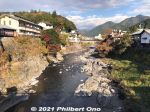
Yoshida River in Gujo-Hachiman looking upstream as seen from Miyagase Bridge. In summer, people fish for ayu sweetfish or swim in the river.
|
|
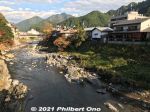
Yoshida River in Gujo-Hachiman looking upstream. There are also cherry blossoms in spring.
|
|
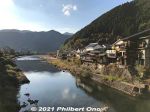
Yoshida River in Gujo-Hachiman looking downstream toward Nagara River.
|
|
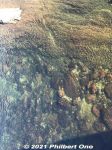
Yoshida River's clear and clean water.
|
|

Roadside monument for a poem by Orikuchi Shinobu in 1919. It was a memorial for the victims of a major fire in the northern part of town.
|
|

Shinbashi Bridge over Yoshida River. Cross this bridge to the Former Hachiman Town Hall and you will be in Minami-machi or the southern part of town.
|
|
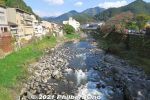
Yoshida River as seen from Shinbashi Bridge.
|
|
|
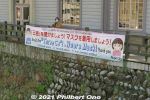
COVID-19 countermeasures.
|
|
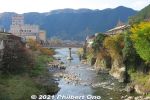
Looking downstream on Yoshida River. Miyagase Bridge can be seen.
|
|
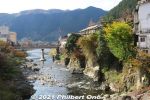
Looking downstream on Yoshida River from Shinbashi Bridge.
|
|
|
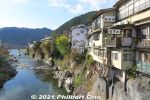
Looking downstream on Yoshida River from Shinbashi Bridge.
|
|
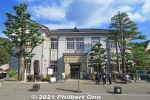
Former Hachiman Town Hall was built in 1936 and served as the Hachiman Town Hall until 1994. It now houses a tourist information center, souvenir shop, and restaurant. 郡上八幡旧庁舎記念館The large plaza in front of the building is one of the main venues for the Gujo Odori Dance held in summer.
|
|
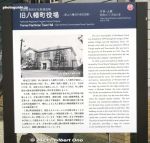
About the Former Hachiman Town Hall.
|
|
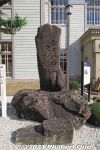
In front of the former Hachiman Town Hall is this monument marking the origin of the Gujo Odori Dance.
|
|

Gift shop inside Former Hachiman Town Hall.
|
|
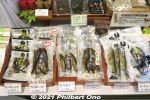
Ayu sweetfish.
|
|

Gujo Odori dance tenugui hand towels.
|
|
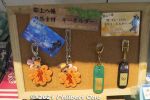
Gujo Odori dance key chains.
|
|
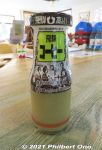
Hida Coffee, locally produced coffee milk.
|
|

Cafe menu. Reasonable prices.
|
|

Traditional-looking homes.
|
|
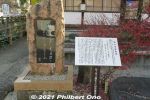
Monument for Noguchi Ujo, poet and lyricist of children's songs and folk music. He composed nine verses of the Gujo Odori song "Kawasaki".
|
|

About Noguchi Ujo and his poem about the beautiful local scenery. 野口雨情歌碑
|
|

Directional signs in Gujo-Hachiman includes English.
|
|
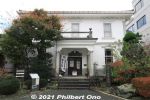
Former Hayashi Clinic. It was closed when I visited.
|
|
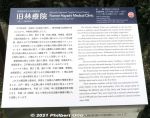
About the former Hayashi Clinic that was donated to the city.
|
|

Gujo-Hachiman Post Office on the left.
|
|
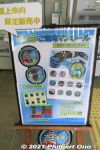
In the post office, stamps showing Gujo-Hachiman's picture manholes.
|
|
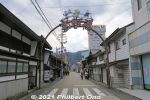
Shinmachi-dori street is the main street in the southern part of town south of Yoshida River.
|
|

Shinmachi-dori street sign with Gujo Odori dancers.
|
|
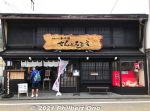
Gujo-Hachiman is also famous for food replicas which were invented by Gujo-Hachiman native Iwasaki Takizo (1895–1965). This shop called Sample Kobo displays a large sample of them. Also for sale. サンプル工房
|
|
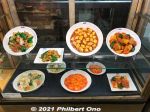
Sample Kobo factory for food replicas which were invented in Gujo-Hachiman. Looks delicious. サンプル工房
|
|

Gujo-Hachiman native Iwasaki Takizo (1895–1965) invented the ubiquitous food replicas we see today in restaurants in Japan.
|
|
|
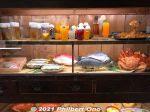
Gujo-Hachiman today makes over 50% of Japan's food replicas. Iwasaki made his first food replica, an omelette, in 1932.
|
|
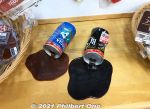
They also offer short lessons to make your own food replicas like spilled coffee.
|
|
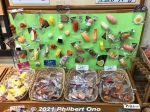
Fake sushi on key chains.
|
|
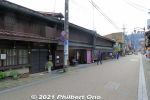
Gujo-Hachiman has a few traditional townscape streets.
|
|
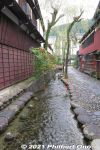
Gujo-Hachiman has a few traditional townscape streets. This is Yanaka Mizu no Komichi (やなか水のこみち). Narrow alley with embedded stones.
|
|
|
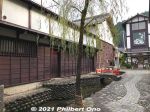
Yanaka Mizu no Komichi (やなか水のこみち). Narrow alley with embedded stones.
|
|
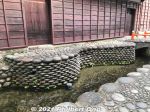
Yanaka Mizu no Komichi, narrow alley with embedded stones.
|
|
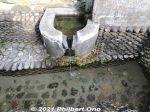
Yanaka Mizu no Komichi
|
|

Yanaka Mizu no Komichi with embedded stones.
|
|
|
|
|
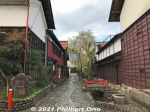
Yanaka Mizu no Komichi
|
|
|
|
|